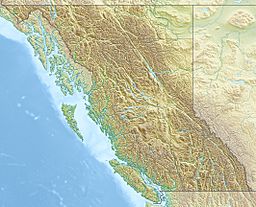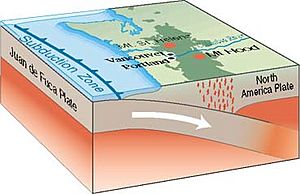Pachena Bay facts for kids
Quick facts for kids Pachena Bay |
|
|---|---|
| Location | British Columbia, Canada |
| Coordinates | 48°46′37″N 125°07′46″W / 48.7770°N 125.1295°W |
| Ocean/sea sources | Pacific Ocean |
| Basin countries | Canada |
| Max. length | 3.29 km (2.04 mi) |
| Max. width | 1.27 km (0.79 mi) |
| Surface area | 4.9 km2 (1.9 sq mi) |
| Average depth | 7 m (23 ft) |
| Max. depth | 16.6 m (54 ft) |
| Settlements | Huu-ay-aht First Nations |
Pachena Bay is a beautiful bay located about 13 kilometers (8 miles) south of Bamfield. You can find it within Pacific Rim National Park at the southern end of Vancouver Island, British Columbia, Canada. This bay is special because it was once home to a First Nations village. Sadly, this village was completely destroyed by a huge tsunami in the year 1700.
Contents
What's in a Name?
The name "Pachena" comes from the Nitinaht Indigenous language. It was originally meant for a different place, but it ended up being used for this bay by mistake. The word "Pachena" means "seafoam" or "foam on the rocks."
Today, the Huu-ay-aht First Nations people live here. They have their own name for this bay, which is "Anacla."
The Huu-ay-aht First Nations
Pachena Bay is the home of the Huu-ay-aht First Nations village called Anacla. According to their oral history, this village was destroyed by a massive earthquake that shook the West Coast of North America a long time ago.
The Huu-ay-aht First Nations is a group of Indigenous people who live on Pachena Bay. This area is about 300 kilometers (186 miles) northwest of Victoria, British Columbia on the west coast of Vancouver Island. The Huu-ay-aht are part of the Nuu-chah-nulth Tribal Council. They are also members of the Maa-nulth Treaty Society.
The Great Cascadia Earthquake
On January 26, 1700, one of the biggest earthquakes ever recorded happened. It caused a huge crack along the Cascadia subduction zone. This zone stretches from Vancouver Island all the way down to northern California. This powerful earthquake created a giant tsunami that completely wiped out the village at Pachena Bay. No one survived.
First Nations people from Vancouver Island to Northern California have similar stories about this earthquake and tsunami. Their legends often describe a battle between a thunderbird and a whale. This battle caused the earth to shake violently and the ocean to wash away their homes and people. The ancient earthquake and tsunami devastated the western shores of Vancouver Island and even reached the eastern coast of Japan.
Stories from the Past
The Huu-ay-aht have a legend about a huge earthquake and ocean wave that destroyed their settlements at Pachena Bay. Their story says it happened on a winter evening after everyone had gone to sleep.
Only one community on Pachena Bay, called Masit, was not destroyed. This was because Masit was located on a mountainside, about 23 meters (75 feet) above sea level. Everyone else from Pachena Bay was lost. A young woman named Anacla aq sop survived because she was staying at Kiix?in. This place was on Barkley Sound, which was more protected from the tsunami. She became known as the last living member of her community.
Today, even though many residents still live in lower areas, they move to a higher administration building if a tsunami warning is issued. There are plans to eventually move all residents to higher ground for their safety.
Connecting the Dots
In 1996, a group of scientists made an amazing discovery. They linked a mysterious tsunami that hit Japan in 1700 to a massive magnitude 9 earthquake and tsunami in North America. They figured out that the earthquake happened on the evening of January 26, 1700.
Scientists used tree-ring dating to confirm the date of this giant North American earthquake.
A 2005 report from the United States Geological Survey (USGS) explained how big this event was. The 1700 Cascadia earthquake likely broke a section of the Earth's crust over 1,000 kilometers (620 miles) long. This is about the length of California or Japan's main island, Honshu! The plates probably moved past each other by about 20 meters (65 feet). The earthquake's strength was likely between magnitude 8.7 and 9.2.
Before the mid-1980s, scientists weren't sure if British Columbia had ever experienced such a huge earthquake. These types of earthquakes, called subduction earthquakes, cause the most damage on land and create tsunamis.
How Scientists Learn About Ancient Earthquakes
Scientists found fragments of wood preserved in the soil. These showed that coastal marshes were destroyed by a tsunami. When they dug deeper, they found layers of sand covering the plant material. Tsunamis wash huge amounts of sand ashore, burying marshes. Over time, the marsh slowly rebuilds itself. The deeper scientists dig, the more layers they find, telling a story of past tsunamis.
Thanks to these discoveries and the oral stories passed down by Indigenous people, we now know that a massive subduction earthquake happened off the coast of Vancouver Island. It caused a fault to rupture all the way to northern California. We can even pinpoint the exact date and time: January 26, 1700, at 9 p.m. Pacific Time.
These sources were key to understanding that huge subduction earthquakes have struck this coast every 250 to 850 years.
Japanese historical documents also describe the tsunami. One document says, "A tsunami struck Kuwagasaki around midnight... water destroyed 13 houses outright and set off fires that destroyed 20 more." The tsunami also caused a shipwreck and damaged rice stores.
By using the wave heights and arrival times recorded in Japan, tsunami scientists and seismologists worked backward. They concluded that the tsunami came from a magnitude 8.7–9.2 earthquake off the coast of Vancouver Island.
Japanese history perfectly matches what we now know about subduction earthquakes. It also aligns with the stories that generations of Indigenous people on Vancouver Island have passed down.
One storyteller shared, "They had practically no way or time to try to save themselves. I think it was at nighttime that the land shook. I think a big wave smashed into the beach. The Pachena Bay people were lost."
Another storyteller said, "It began in the middle of the night, and shaking was so severe that it made people sick. It threw down their houses and brought great masses of rock down from the mountains."



